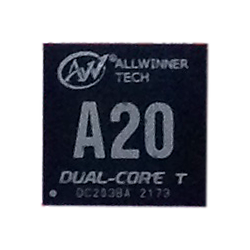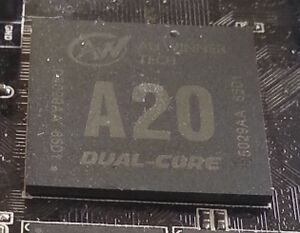A20
| A20 | |
|---|---|
 | |
| Manufacturer | Allwinner |
| Process | 40nm |
| CPU | Dual-Core ARM Cortex-A7 |
| Memory | LPDDR3/DDR3/LPDDR2 |
| GPU | Mali400 MP2 |
| Connectivity | |
| Video | HDMI 1.4, CVBS, YPbPr, VGA, CPU/RGB/LVDS LCD |
| Audio | I2S, PCM, AC97 |
| Storage | MMC, NAND, SATA |
| USB | OTG, 2x Host |
| Release Date | December 2012 |
| Website | Product Page |
Allwinner A20 (sun7i) SoC features a Dual-Core Cortex-A7 ARM CPU, and a Mali400 MP2 GPU from ARM.
Allwinner A20 is a low-end (budget) version of the A31. It shares its Cortex-A7 ARM CPU architecture, but at the same time it is also pin-to-pin compatible with A10.
A20 is fully supported by the community from linux-sunxi 3.4 kernel and later.
Overview
A20 CPU consists of dual ARM Cortex-A7 cores, and integrates the Mali400 MP2 GPU. Together with Cedar Engine multimedia processing unit that is capable of up to 2160p (3840x1080@30fps 4k resolution or 1080p 3D decoding) video decoding, with integrated HDMI 1.4 output support, and H.264 HP (High Profile) in 1080p at 30fps video encoding.
Main components of the A20
- CPU: Dual-Core ARM Cortex-A7 1GHz Processor (r0p4, revidr=0x0) which have both VFP4 and NEON SIMD co-processors that share 32 floating point double-precision registers together[1]:
- FPU: standard ARM VFPv4-D32 FPU Floating Point Unit
- SIMD: NEON (ARM's extended general-purpose SIMD vector processing extension engine)
- GPU: Mali400 MP2
- VPU: Cedar Engine (Video Processor Unit for audio and video hardware decoding or encoding)
- HDMI-transmitter: HDMI CEC (Consumer Electronics Control)
Cortex-A7
Cortex-A7 is 100% ISA compatible with the Cortex-A15, this includes the new virtualization instructions, integer divide support and 40-bit memory addressing. Any code running on an A15 can run on a Cortex A7, just slower. This is a very important feature as it enables SoC vendors to build chips with both Cortex A7 and Cortex A15 cores, switching between them depending on workload requirements. ARM calls this a big.LITTLE configuration.[2][3][4]
Virtualization
Cortex A7 and A15 includes hardware virtualization support.
- It is managed by Xen (Presentation of Cortex A7 and A15 capabilities for virtualisation, Xen ARM on xenproject.org, PVH mode on blog.xen.org, Xen ARMv7 with Virtualization Extensions on xenproject.org wiki)
On the kvm branch of kernel.org, there is description of Cortex-A15 Virtualization extensions VGIC registers :
After the ARM Cortex-A7 documentation:
- GIC memory MAP on Cortex-A7[5]:
0x4000-0x4FFF Virtual interface control, common base address 0x5000-0x5FFF Virtual interface control, processor-specific base address 0x6000-0x7FFF Virtual CPU interface
- Virtual Maintenance Interrupt (PPI6)[6]
- 2 virtual interrupt signals, nVIRQ and nVFIQ[7]
- With MMU-400, Intermediate Physical Address (IPA) ca be used by guest OS[8]
A20 SoC Features

- CPU
- ARM Cortex-A7 Dual-Core (revision r0p4)
- 256KiB L2-Cache (shared between two cores)
- 32KiB (Instruction) / 32KiB (Data) L1-Cache per core
- SIMD NEON, VFP4
- Virtualization
- Large Physical Address Extensions (LPAE) 1TB
- GPU
- ARM Mali400 MP2
- Featuring 1 vertex shader (GP) and 2 fragment shaders (PP).
- Complies with OpenGL ES 2.0
- Memory
- LPDDR2/DDR3/DDR3L controller
- NAND Flash controller and 64-bit ECC
- Video
- HD H.264 2160P video decoding
- Full HD video decoding
- BD Directory, BD ISO and BD m2ts video decoding
- H.264 High Profile 1080P@30fps encoding
- 3840×1080@30fps 3D decoding
- Complies with RTSP, HTTP,HLS,RTMP,MMS streaming media protocol
- Display
- Support multi-channel HD display
- Integrated HDMI 1.4
- CPU/RGB/LVDS LCD interface 1920×1080 resolution
- CVBS/YPbPr/VGA support
- Integrated TV decoder
- 4 × up to 8096×8096 bitmaps layers
- 32 × 32bits aRGB or 8bpp palette sprites blocks of up to 4096 (12 bits)×4096 size.
- Camera
- Integrated parallel 8-bit I/F YUV sensor
- Integrated 24-bit parallel YUV 444 I/F
- 5M/8M CMOS sensor support
- Dual-sensor support
- Audio
- Integrated HI-FI 100dB Audio Codec
- Dual MIC noise cancellation
- package: BGA441 19 mm × 19 mm (0.80 mm Pitch)
Documentation
- Allwinner A20 Manual v1.40 (PDF, 857 pages, 2015-04-20)
- Allwinner A20 Datasheet v1.50 (PDF, 36 pages, 2015-04-06)
- A20 Product Brief (Outdated)
- A20 User Manual (Outdated v1.0)
DVFS
The A20 SoC supports dynamic voltage & frequency scaling. Below are the DVFS operating points, as documented in the A20 SDK (lichee-v2.0.tar.gz):
; dvfs voltage-frequency table configuration ; ; max_freq: cpu maximum frequency, based on Hz, can not be more than 1008MHz ; min_freq: cpu minimum frequency, based on Hz, can not be less than 60MHz ; ; LV_count: count of LV_freq/LV_volt, must be < 16 ; ; LV1: core vdd is 1.45v if cpu frequency is (912Mhz, 1008Mhz] ; LV2: core vdd is 1.40v if cpu frequency is (864Mhz, 912Mhz] ; LV3: core vdd is 1.30v if cpu frequency is (792Mhz, 864Mhz] ; LV4: core vdd is 1.25v if cpu frequency is (720Mhz, 792Mhz] ; LV5: core vdd is 1.20v if cpu frequency is (624Mhz, 720Mhz] ; LV6: core vdd is 1.15v if cpu frequency is (528Mhz, 624Mhz] ; LV7: core vdd is 1.10v if cpu frequency is (312Mhz, 528Mhz] ; LV8: core vdd is 1.05v if cpu frequency is ( 60Mhz, 312Mhz]
Software
Original SDKs
We have made some SDKs available on our server:
GPL Violations
Devices
See also
References
- ↑ Cortex-A7 MPCore Technical Reference Manual — 1.3. Features
- ↑ http://www.anandtech.com/show/4991/arms-cortex-a7-bringing-cheaper-dualcore-more-power-efficient-highend-devices
- ↑ http://en.wikipedia.org/wiki/ARM_Cortex-A7_MPCore
- ↑ http://www.arm.com/products/processors/cortex-a/cortex-a7.php
- ↑ Cortex-A7 MPCore Technical Reference Manual - 8.2.1. GIC memory-map
- ↑ Cortex-A7 MPCore Technical Reference Manual - 8.2.2. Interrupt sources
- ↑ Cortex-A7 MPCore Technical Reference Manual - 8.2.4. GIC configuration
- ↑ CoreLink MMU-400 System Memory Management Unit Technical Reference Manual - 1.1. About the MMU-400